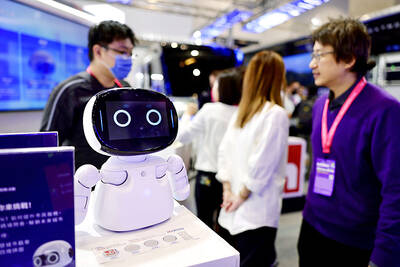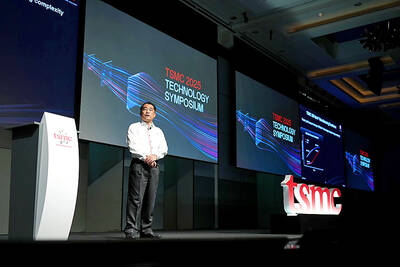The Samsung Electronics Co announced on Friday that it will spend US$500 million to upgrade its only overseas chip plant, in Austin, Texas. Within hours of that announcement, Samsung's stock price dropped 2.4 percent -- North Korean officials had announced that they had the capability to make nuclear bombs.
Such are the gritty challenges that confront Samsung, the largest company in South Korea, a pulsating, high-tech country that shares a peninsula with a militarized, impoverished nation where few people are allowed to have telephones.
In China, Samsung's largest Asian export market, consumer demand is withering as a respiratory virus scares people away from markets and department stores where cell phones, DVD players and flat-screen televisions are languishing on the shelves. Around Asia, prices of computer chips, a major Samsung product, are falling as new American and European tariff barriers against Hynix, a rival company supported by the Korean government, are expected to cause excess Korean-made chips to flood the region.
Samsung sales in South Korea dropped by 28 percent this past quarter over the same quarter last year. The decline seems to be a result of potential customers' soaring credit card debt over the last year. About 500,000 South Koreans in their 20s, or about one in 15, are facing bankruptcy.
Last week, Samsung announced a 41 percent drop in profits for the quarter ended March 31, to US$1.1 billion in operating profit. In response, Samsung increased its already aggressive investment budget to US$5.65 billion, nearly two-thirds higher than last year's.
Since 1996, Samsung has been run by Yun Jong Yong, a soft-spoken engineer who believes that a good dose of crisis and chaos will keep South Korea's No. 1 company agile and resourceful, fighting as if it were No. 3.
A mass producer of cheap electronics only a decade ago, Samsung is now the world's largest producer of memory chips and flat screens. Its market capitalization is now bigger than that of its Japanese rival Sony Corp. Last year, Samsung was the world's third most profitable electronics company, after General Electric Co and Microsoft.
"Some people think that Samsung is a Japanese company. We don't care about that," Chang Il-Hyung, Samsung's top spokesman, said, gliding over 1,000 years of Korean-Japanese rivalry. "Nationality is not that important to us. We are focusing on making Samsung a global market player."
Sony's sales volumes still dwarf those of Samsung, but Sony's profitability is far lower. During the first quarter of this year, Samsung Electronics earned US$942 million in net profit on US$8 billion in sales. By comparison, Sony earned a similar amount, US$963 million for the full fiscal year ended March 31, but that was on US$62.3 billion in sales. On Thursday, Sony announced a 1.5 percent profit on sales for the fiscal year, compared to 17.5 percent for Samsung last year.
In a reversal from a decade ago, when Japan dominated the world chip market, the nearly US$500 million in profits recorded during the first quarter of this year by Samsung's semiconductor division is about equal to the forecasted combined profits for Japan's five largest chipmakers -- Toshiba, NEC Corp, Hitachi, Mitsubishi Electric Corp and Fujitsu Ltd.
And Samsung has said it plans to invest about US$3.4 billion in new chip plants and equipment this year. By contrast, the investment plans of Japan's five largest chipmakers add up to about US$2 billion.
Among major makers of memory chips, Samsung is only company to clear a profit. This year, it expects to sell US$7 billion worth of memory chips.
Niche products like graphics chips for game consoles and flash memory chips for cell phones and hand-held computers have helped Samsung make money in an industry plagued by overcapacity and declining demand. And last year, Samsung moved to a newer, more expensive chip, the DDR, or double data-rate, chip. But with the market flooded with chips, prices for the standard D-ram chips are down by almost 50 percent compared to the same time a year ago.
Although Samsung is dependent on the memory chip market, chips accounted for only 23 percent of Samsung's sales during the last quarter.
But in a highly competitive sector, three of Samsung's main products -- chips, cell phones and liquid-crystal display screens -- saw sales increase last year, even though prices went down. And it has been affected by consumer credit problems.
"They have to inject money, from US$110 million to US$470 million, to bail out their credit-card company," said Jon Chong-Hwa, director of equity research at Daewoo Securities, referring to Samsung Card Co, which is 56 percent owned by Samsung Electronics.
In the fast-moving flat-screen field, LG Philips LCD, a South Korean-Dutch joint venture, nosed ahead of Samsung late last year to become the world's largest producer for a quarter. In a sharp counterattack, Samsung announced a month ago that it would invest US$1 billion in a new flat-screen production plant, adding 60 percent to its production capacity. Of the US$650 million in new investments announced last week, almost all the money is to go to making thin-film-transistor liquid-crystal displays, the main component in LCD monitors, laptop computer screens and some flat-panel televisions.
In mobile phones, Samsung has come from virtually nowhere to become the fastest growing of the world's big three manufacturers, surpassing Nokia of Finland and Motorola of the US. In the last two years, Samsung doubled its share of the world market, selling US$10 billion worth of cell phones last year. This year, it plans to increase its market share to 12 percent of the 435 million cell phones expected to be sold around the world this year.

DEMOGRAPHICS: Robotics is the most promising answer to looming labor woes, the long-term care system and national contingency response, an official said Taiwan is to launch a five-year plan to boost the robotics industry in a bid to address labor shortages stemming from a declining and aging population, the Executive Yuan said yesterday. The government approved the initiative, dubbed the Smart Robotics Industry Promotion Plan, via executive order, senior officials told a post-Cabinet meeting news conference in Taipei. Taiwan’s population decline would strain the economy and the nation’s ability to care for vulnerable and elderly people, said Peter Hong (洪樂文), who heads the National Science and Technology Council’s (NSTC) Department of Engineering and Technologies. Projections show that the proportion of Taiwanese 65 or older would

Nvidia Corp yesterday unveiled its new high-speed interconnect technology, NVLink Fusion, with Taiwanese application-specific IC (ASIC) designers Alchip Technologies Ltd (世芯) and MediaTek Inc (聯發科) among the first to adopt the technology to help build semi-custom artificial intelligence (AI) infrastructure for hyperscalers. Nvidia has opened its technology to outside users, as hyperscalers and cloud service providers are building their own cost-effective AI chips, or accelerators, used in AI servers by leveraging ASIC firms’ designing capabilities to reduce their dependence on Nvidia. Previously, NVLink technology was only available for Nvidia’s own AI platform. “NVLink Fusion opens Nvidia’s AI platform and rich ecosystem for

Taiwan Semiconductor Manufacturing Co (TSMC, 台積電) yesterday said it is building nine new advanced wafer manufacturing and packaging factories this year, accelerating its expansion amid strong demand for high-performance computing (HPC) and artificial intelligence (AI) applications. The chipmaker built on average five factories per year from 2021 to last year and three from 2017 to 2020, TSMC vice president of advanced technology and mask engineering T.S. Chang (張宗生) said at the company’s annual technology symposium in Hsinchu City. “We are quickening our pace even faster in 2025. We plan to build nine new factories, including eight wafer fabrication plants and one advanced

‘WORLD’S LOSS’: Taiwan’s exclusion robs the world of the benefits it could get from one of the foremost practitioners of disease prevention and public health, Minister Chiu said Taiwan should be allowed to join the World Health Assembly (WHA) as an irreplaceable contributor to global health and disease prevention efforts, Minister of Foreign Affairs Lin Chia-lung (林佳龍) said yesterday. He made the comment at a news conference in Taipei, hours before a Taiwanese delegation was to depart for Geneva, Switzerland, seeking to meet with foreign representatives for a bilateral meeting on the sidelines of the WHA, the WHO’s annual decisionmaking meeting, which would be held from Monday next week to May 27. As of yesterday, Taiwan had yet to receive an invitation. Taiwan has much to offer to the international community’s